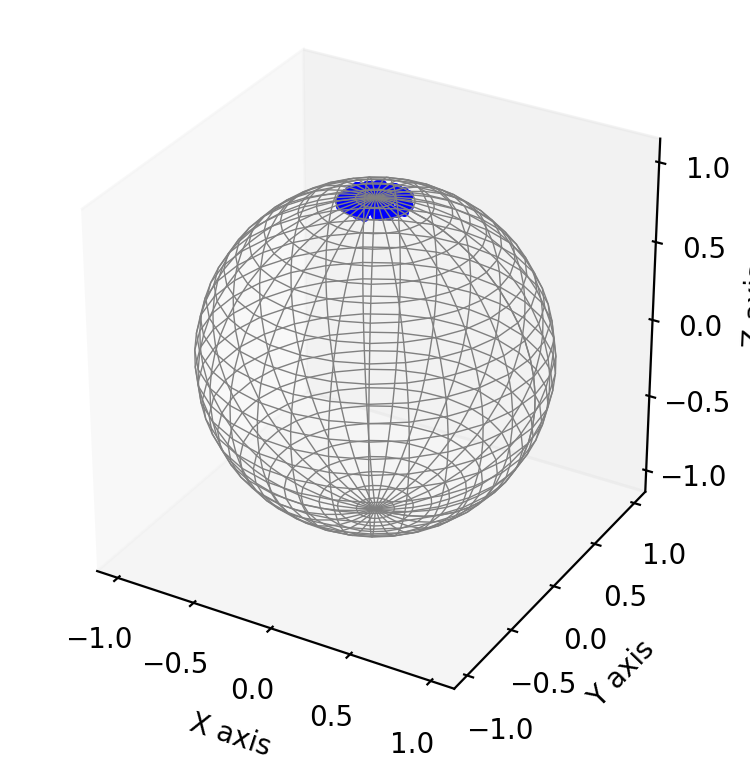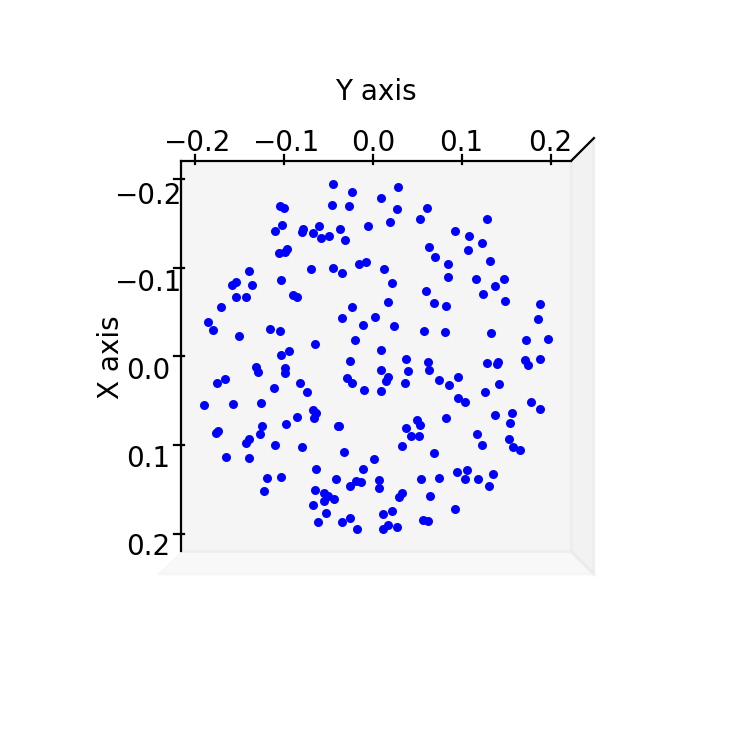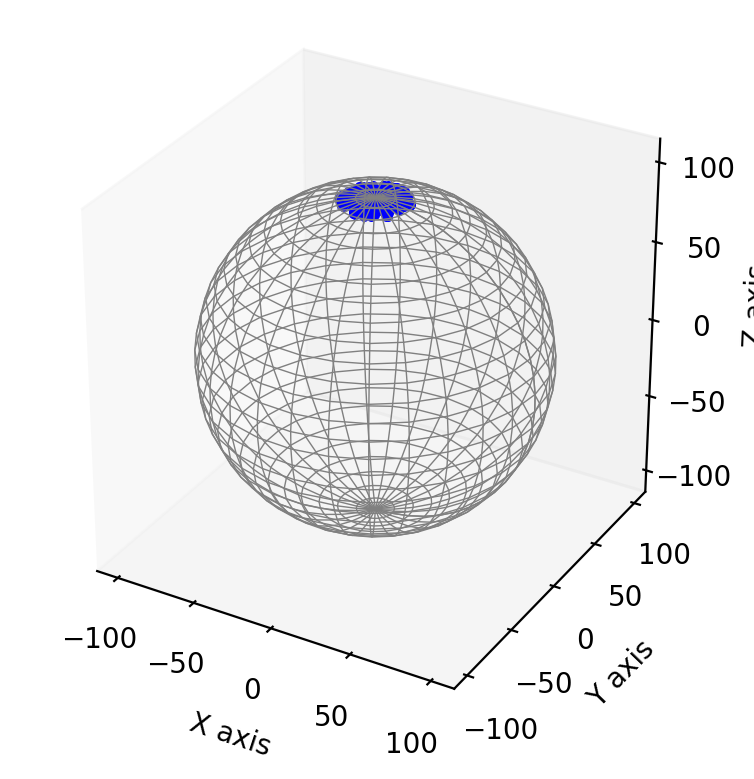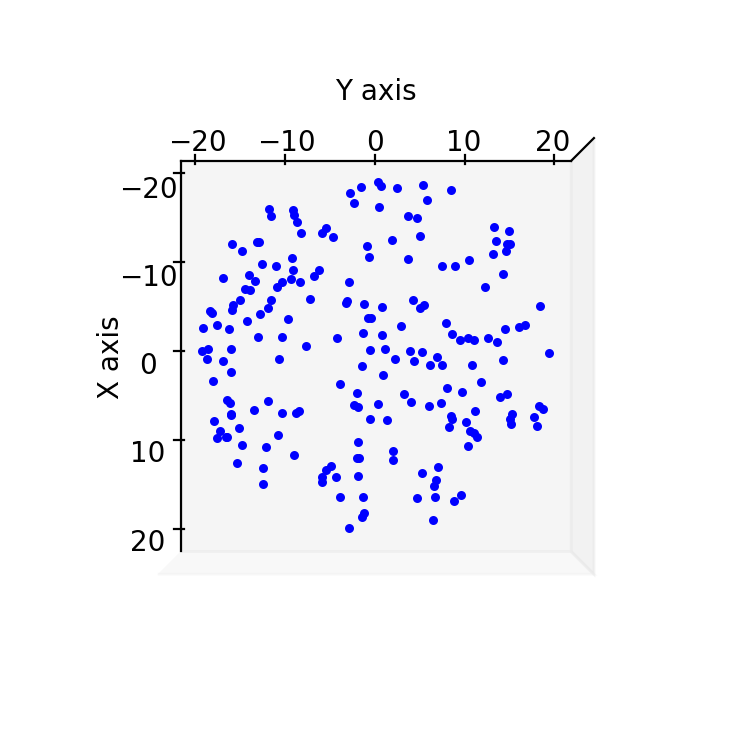Testing generation of random points on a sphere and spherical cap
Scott Prahl
Feb 2924
[1]:
import matplotlib.pyplot as plt
import numpy as np
from mpl_toolkits.mplot3d import Axes3D
import random
import iadpython
%config InlineBackend.figure_format='retina'
[2]:
def draw_circle(radius=1, color='blue'):
theta = np.linspace(0, 2 * np.pi, 100)
x = radius * np.cos(theta)
y = radius * np.sin(theta)
plt.plot(x, y, color=color, lw=0.5)
def draw_sphere(ax, sphere_radius=1, color='gray'):
phi = np.linspace(0, np.pi, 30) # polar angle
theta = np.linspace(0, 2 * np.pi, 30) # azimuthal angle
phi, theta = np.meshgrid(phi, theta)
# Convert spherical coordinates to Cartesian coordinates for the sphere's surface
x = sphere_radius * np.sin(phi) * np.cos(theta)
y = sphere_radius * np.sin(phi) * np.sin(theta)
z = sphere_radius * np.cos(phi)
# Plot the wireframe
ax.plot_wireframe(x, y, z, color=color, lw=0.5)
Check sagitta calculation
[3]:
radius = 50
d_sample = 40
sphere = iadpython.Sphere(2*radius, d_sample)
print(sphere)
s = sphere.sample.sagitta
draw_circle(radius, 'gray')
plt.plot([0,0],[0,radius])
plt.plot([-d_sample/2, d_sample/2],[radius-s, radius-s])
plt.axis('equal')
plt.show()
Sphere
diameter = 100.00 mm
radius = 50.00 mm
relative area = 0.9583
uru walls = 99.0%
uru standard = 99.0%
baffle = False
Sample Port
diameter = 40.00 mm
radius = 20.00 mm
chord = 20.43 mm
sagitta = 4.17 mm
center = ( 0.0, 0.0, -50.0) mm
relative area = 0.0417
uru = 0.0000
Detector Port
diameter = 0.00 mm
radius = 0.00 mm
chord = 0.00 mm
sagitta = 0.00 mm
center = ( 50.0, 0.0, 0.0) mm
relative area = 0.0000
uru = 0.0000
Empty Port
diameter = 0.00 mm
radius = 0.00 mm
chord = 0.00 mm
sagitta = 0.00 mm
center = ( 0.0, 0.0, 50.0) mm
relative area = 0.0000
uru = 0.0000
Multipliers
nothing = 0.000
standard = 94.867

Visually test the generation of points on a spherical surface
[7]:
sphere_radius = 5
d_sample = 1
sphere = iadpython.Sphere(2*radius, d_sample)
plt.figure()
ax = plt.axes(projection='3d')
draw_sphere(ax, sphere_radius, 'gray')
for i in range(300):
x, y, z = sphere.uniform() * 5
ax.scatter(x, y, z, color='blue', s=5)
ax.set_xlabel('X axis')
ax.set_ylabel('Y axis')
ax.set_zlabel('Z axis')
ax.set_box_aspect([1,1,1])
ax.grid(False)
plt.show()

Visually test the generation of points on a spherical cap
First, the unit sphere
[11]:
sphere_radius = 1
port_diameter = 0.4
s = iadpython.Sphere(2 * sphere_radius, port_diameter)
h = s.sample.sagitta
plt.figure()
ax = plt.axes(projection='3d')
draw_sphere(ax, sphere_radius)
for i in range(200):
x, y, z = s.sample.uniform()
ax.scatter(x, y, z, color='blue',s=5)
ax.set_xlabel('X axis')
ax.set_ylabel('Y axis')
ax.set_zlabel('Z axis')
ax.set_box_aspect([1,1,1])
ax.grid(False)
plt.show()
plt.figure()
ax = plt.axes(projection='3d')
ax.view_init(elev=90, azim=0) # or azim=180
for i in range(200):
x, y, z = s.sample.uniform()
ax.scatter(x, y, z, s=5, color='blue')
# Setting the labels for each axis
ax.set_xlabel('X axis')
ax.set_ylabel('Y axis')
ax.set_zlabel('')
ax.set_box_aspect([1,1,1])
ax.grid(False)
ax.zaxis.set_ticklabels([])
ax.zaxis.set_ticks([])
plt.show()


Now a larger sphere
[14]:
sphere_radius = 100
port_diameter = 40
s = iadpython.Sphere(2 * sphere_radius, port_diameter)
h = s.sample.sagitta
plt.figure()
ax = plt.axes(projection='3d')
draw_sphere(ax, sphere_radius)
for i in range(200):
x, y, z = s.sample.uniform()
ax.scatter(x, y, z, color='blue',s=5)
ax.set_xlabel('X axis')
ax.set_ylabel('Y axis')
ax.set_zlabel('Z axis')
ax.set_box_aspect([1,1,1])
ax.grid(False)
plt.show()
plt.figure()
ax = plt.axes(projection='3d')
ax.view_init(elev=90, azim=0) # or azim=180
for i in range(200):
x, y, z = s.sample.uniform()
ax.scatter(x, y, z, s=5, color='blue')
ax.set_xlabel('X axis')
ax.set_ylabel('Y axis')
ax.set_zlabel('')
ax.set_box_aspect([1,1,1])
ax.grid(False)
ax.zaxis.set_ticklabels([])
ax.zaxis.set_ticks([])
plt.show()


Rotate random point on cap properly
Some work remains to rotate the top cap so that its center conicides with the designated center of the cap. I am setting this aside because it is not needed.
[ ]: